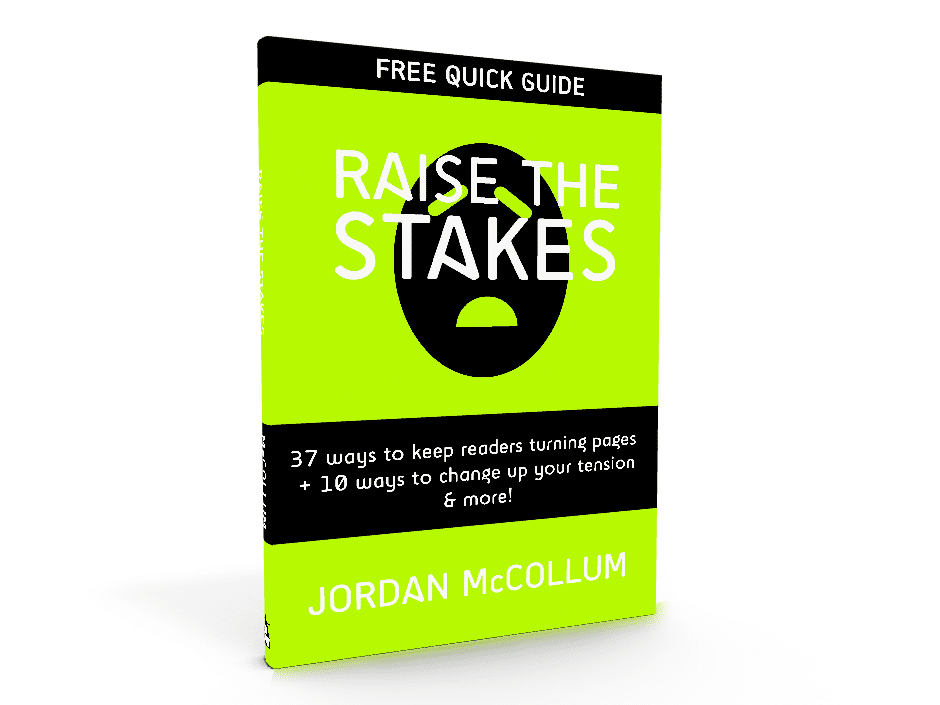by Annette Lyon
 When I first started writing seriously (back in the Jurassic era), the more I tried to learn, the more there seemed to be to learn. And there was so much.
When I first started writing seriously (back in the Jurassic era), the more I tried to learn, the more there seemed to be to learn. And there was so much.
For me, the language side of writing came relatively easy; my brain simply works in a way that grammar, usage, mechanics, and punctuation are easy to grasp. It was the bones of writing, the structure, the storytelling aspect, that took longer.
As I continued to write and study the craft, I began to see a pattern: whether it’s showing instead of telling, creating great description, rounding out characters, writing riveting action or just about anything else, one of the best ways to do all of those things is through a single tool in my writer’s toolkit.
My secret weapon is simple but powerful. Chances are if a scene isn’t working or the pace is aging or any number of other problems crop up, I can fix it by improving one thing: point of view.
I won’t go into the types of point of view here (first, limited third, tight third, omniscient, and so on). Study those yourself to learn contemporary trends and why different types work in different situations. (A great place to start: Orson Scott Card’s Character and Viewpoint.)
Here’s the secret: When you know who your POV character is for any given scene, the world of your story opens up to you.
For example, a writer recently asked me how to make his descriptions better; he wasn’t sure how much description to include of a room or some other location, or how to create a description without stopping the plot.
No surprise, my answer went straight to POV. I used the lobby at the conference we were at as an example. If it’s a man who has just walked in from the hot sun after hours of working on his car, chances are he’d first notice the Pepsi machine. Maybe he’d then be annoyed, because he’s a Coke guy. Maybe he then looks for a drinking fountain or settles for a Dr. Pepper before finding one of the couches to relax on—feet propped on the coffee table.
Or if it’s a business woman with a design background, maybe she’d first notice the decorative metal piece hanging on the wall—and either think it was tacky or unique and fun. She’d probably wonder who picked out the puke yellow paint for the walls, and if she took a seat on the couches, instead of reclining, she’d find a plug in the wall and prop open her laptop to work—likely giving Mr. Smelly Mechanic a look and wishing he’d put his arms down so he wouldn’t be quite so odiferous.
In both cases, I picked a specific personality to view the very same room, and each person found different items they noticed first. That’s the key with POV—what is the lens through which your character sees the world? What does this particular character notice? What does he or she like or dislike? What does he or she want?
If an eight-year-old girl obsessed with princesses came into the room, what would she notice first? What about a ninety-year-old retired biology professor? A middle-aged homeless woman?
What your character notices—whether in the description of a room, in dialog with other characters, what they see in another person’s demeanor—is just as important as what they don’t notice. How they do and do not feel about those things matters.
Imagine what the Harry Potter series would have been like written from Draco’s POV. Snape would be a total hero from page one. We’d think Hagrid is a nincompoop and view Dumbledore as a has-been.
The more I’ve played with POV in creating characters and scenes that come alive, the more POV almost feels like the best cheat ever—I can show without trying so hard, simply by remembering to look at the story world through my POV character eyes. My plot moves forward, the conflict intensifies, and more, all by staying true to POV.
Which is also why not knowing how to use POV well can have a disastrous effect of your story. Instead of pulling your reader into your world and holding them there, poor handling of POV pushes the reader out and constantly reminds them that they’re reading a story that someone else created.
Or worse, bad POV can confuse readers to the point that they shrug and simply give up, closing the book (or turning off the e-reader) and moving on to something else.
I’m almost a nerd about how excited I get over POV and all the many uses it has. It’s definitely my secret sauce, no matter what kind of story I’m writing.
About the Author
Annette Lyon is a Whitney Award winner, a two-time recipient of Utah’s Best in State medal for fiction, and the author of ten novels, a cookbook, and a grammar guide as well as over a hundred magazine articles. She’s a senior editor at Precision Editing Group and a cum laude graduate from BYU with a degree in English. When she’s not writing, editing, knitting, or eating chocolate, she can be found mothering and avoiding the spots on the kitchen floor. Find her online at blog.annettelyon.com and on Twitter: @AnnetteLyon
This year, she’s released Band of Sisters: Coming Home, the second edition of There, Their, They’re: A No-Tears Guide to Grammar from the Word Nerd, and novellas in the Timeless Romance Anthology series.


 First, I should quickly define deep point of view. (I go into this in much greater depth in my book,
First, I should quickly define deep point of view. (I go into this in much greater depth in my book,  But maybe you think there’s no absolute reality, and that the only way to get close to knowing reality is to juxtapose the accounts of several people, a collage-like effect that is very similar to multiple POV. Now we single-POV types, we don’t know if there’s an absolute reality, and in fact, we don’t much care. We’re mostly concerned with the inner reality of characters, what they think and notice and value.
But maybe you think there’s no absolute reality, and that the only way to get close to knowing reality is to juxtapose the accounts of several people, a collage-like effect that is very similar to multiple POV. Now we single-POV types, we don’t know if there’s an absolute reality, and in fact, we don’t much care. We’re mostly concerned with the inner reality of characters, what they think and notice and value.  Private-eye novels, on the other hand, are indeed about the character of the detective (and the detective’s voice), so that snarky first-person narration allows that. The genres evolved a preferred POV approach because that approach usually (never say always 🙂 ) allows writers to create the experience for the reader which is desired in that genre (chills and fear in the thriller, thoughtfulness in the mystery, etc.).
Private-eye novels, on the other hand, are indeed about the character of the detective (and the detective’s voice), so that snarky first-person narration allows that. The genres evolved a preferred POV approach because that approach usually (never say always 🙂 ) allows writers to create the experience for the reader which is desired in that genre (chills and fear in the thriller, thoughtfulness in the mystery, etc.).  That’s a tough one—truly, a real conundrum. I have this problem all the time with characters who either a.) would never, ever sit around describing their everyday world or b.) think and speak in slang or obscure terms that not every reader is going to understand, but everyone else in the scene would.
That’s a tough one—truly, a real conundrum. I have this problem all the time with characters who either a.) would never, ever sit around describing their everyday world or b.) think and speak in slang or obscure terms that not every reader is going to understand, but everyone else in the scene would. I’d also like a little more insight into exactly what she’s feeling there. She goes from a sad smile and tears in her eyes to door slamming, punching and growling. In these paragraphs, we see a good view of her penitence and regret, but the rest of the emotional progression could be a little clearer, since we’re in her head with her. (It’s kinda crowded, I know, but it’s where lots of readers like to be.)
I’d also like a little more insight into exactly what she’s feeling there. She goes from a sad smile and tears in her eyes to door slamming, punching and growling. In these paragraphs, we see a good view of her penitence and regret, but the rest of the emotional progression could be a little clearer, since we’re in her head with her. (It’s kinda crowded, I know, but it’s where lots of readers like to be.) I’m divided on this issue in my WIP, so I’d like to hear your opinions. When reading something in fairly deep POV, is it more natural to refer to the POV character’s family members as “his dad” or just “Dad”? Both have their advantages and disadvantages in my opinion, and I’ve seen both in first-person as well. I’m still pretty torn, so I’m turning it over to you. (Update: I’ve found my
I’m divided on this issue in my WIP, so I’d like to hear your opinions. When reading something in fairly deep POV, is it more natural to refer to the POV character’s family members as “his dad” or just “Dad”? Both have their advantages and disadvantages in my opinion, and I’ve seen both in first-person as well. I’m still pretty torn, so I’m turning it over to you. (Update: I’ve found my  It started off promising. The beginning showed the Jackson 5 practicing their music and dancing, and the rigors of their lives. It showed the psychological relationships of the characters. But instead of delving deeper and deeper into Michael’s psyche over time, the movie seemed to pull back. As Michael seems to push his family away to pursue a solo career, we see less and less of him—and it feels like we’re being pushed away, too. We go from seeing his insecurities and fears to looking in at Neverland from the outside, just like we always have.
It started off promising. The beginning showed the Jackson 5 practicing their music and dancing, and the rigors of their lives. It showed the psychological relationships of the characters. But instead of delving deeper and deeper into Michael’s psyche over time, the movie seemed to pull back. As Michael seems to push his family away to pursue a solo career, we see less and less of him—and it feels like we’re being pushed away, too. We go from seeing his insecurities and fears to looking in at Neverland from the outside, just like we always have. While this is a powerful technique, point of view has always been a limitation of film. There has never been and may never be a satisfactory adaptation of
While this is a powerful technique, point of view has always been a limitation of film. There has never been and may never be a satisfactory adaptation of 
